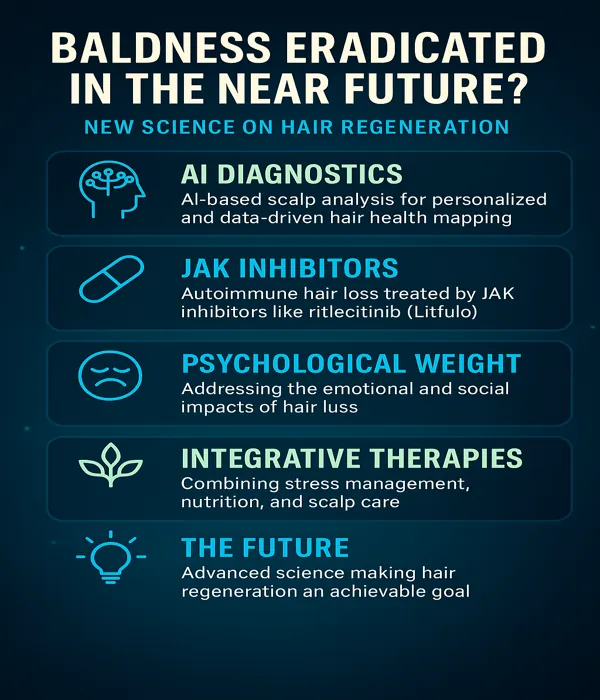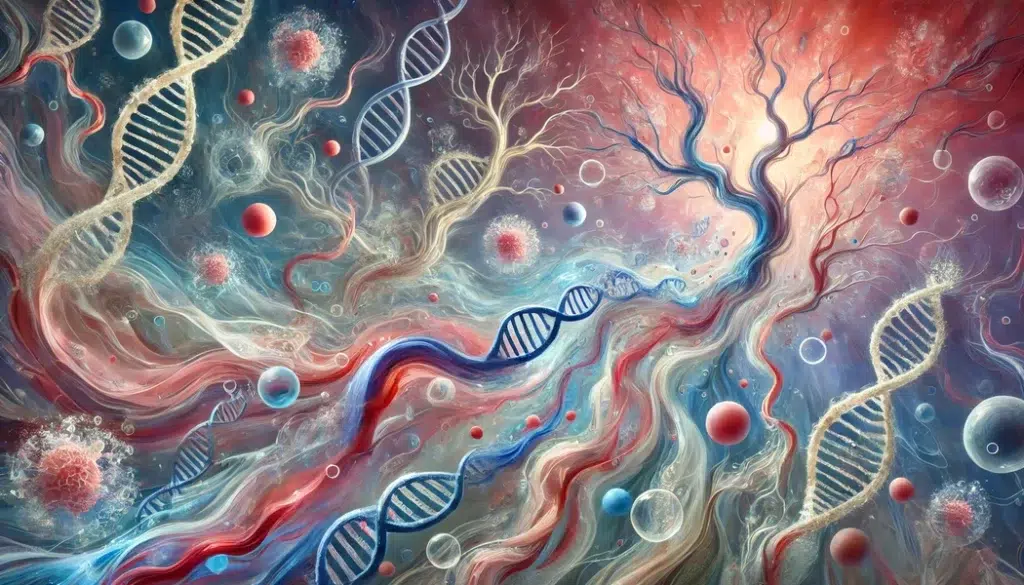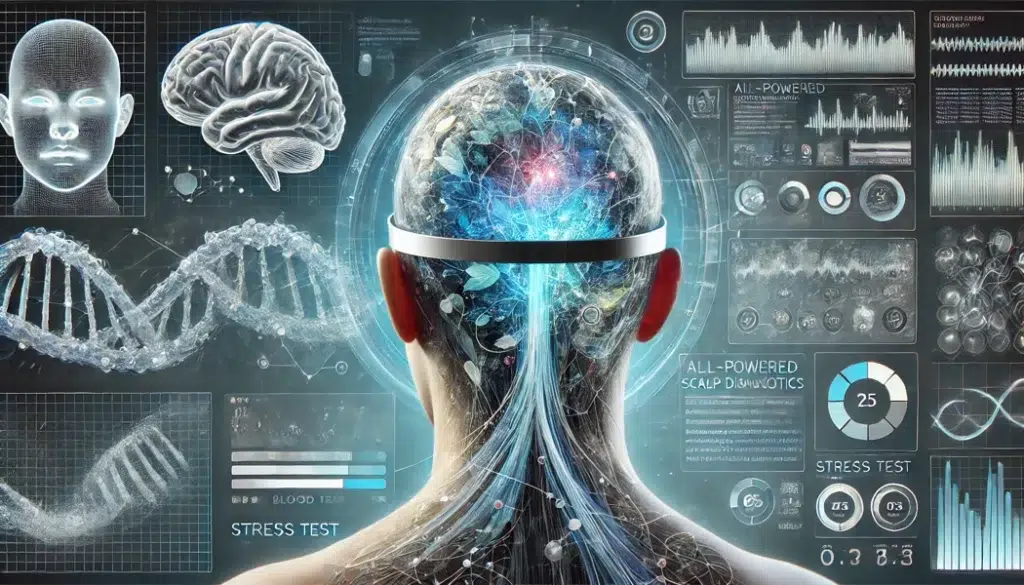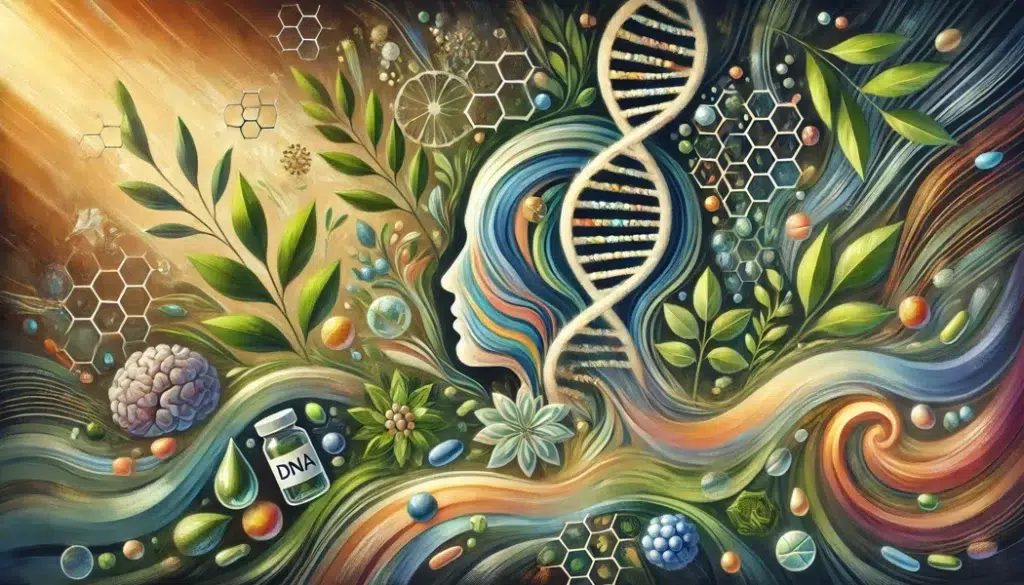Hair loss used to be a one-way road. Once it started, the options were limited: slow it down, cover it up, or learn to live with it. But in recent years, science has shifted gears — and now, for the first time, researchers aren’t just asking how to slow hair loss…
They’re asking how to reverse it.
From molecules that wake up dormant follicles, to stem-cell messengers and even AI-driven scalp diagnostics, the future of hair restoration no longer looks like fiction. It looks like clinical trials, molecular breakthroughs, and real, testable hope. 🧪
In this article, we’ll walk through the latest discoveries — some still in development, others already making waves — and show how they’re reshaping what we thought we knew about baldness.
And no — this isn’t about miracle oils or overnight success. It’s about what credible science is doing right now to solve a problem that affects millions
🧠 The Era of Real Regeneration
For decades, the gold standard in hair loss treatment was simply damage control: slow the shedding, block DHT, maybe stimulate a bit of growth if you’re lucky. But now, the conversation has changed. The new question is: Can we regenerate hair from the ground up — biologically, structurally, and sustainably?
That’s where science is now headed. In the past two years alone, researchers have made breakthroughs once thought impossible: reactivating dormant follicles, boosting cellular energy in the scalp, and enhancing microcirculation in ways that go far beyond cosmetic fixes.
One of the most promising developments involves a cellular protein known as MCL-1, which plays a crucial role in sustaining follicle viability and preventing their programmed death. By boosting MCL-1 expression, researchers have managed to prolong the growth phase and potentially trigger lasting regeneration.
👉 We’ve already covered that game-changing research here:
Revolutionary Discovery in Hair Growth

But that’s just the beginning. Let’s look at what else science is unlocking — and how these innovations might reshape the future of hair recovery for good. 🔬
🍬 Deoxyribose: The Sweet Science Behind Vascular Hair Growth
A 2024 study published in Frontiers in Pharmacology found that topical 2-deoxy-D-ribose (2dDR) gel increased microvascular density and promoted hair regrowth in C57BL/6 mice — with comparable results to minoxidil but fewer side effects.
Most people haven’t heard of deoxyribose — but your scalp just might care. This naturally occurring sugar, a key structural component of DNA, has recently gained attention not for its genetic role, but for something much more unexpected: stimulating blood vessel formation in the skin.
In a recent study conducted on mice, topical application of deoxyribose significantly increased vascular density around hair follicles. What does that mean in plain terms? Better blood flow, better oxygenation, and better nutrient delivery to the follicle base — all critical factors for regrowth. 💡
Even more impressive, its results were comparable to those of minoxidil, but without the known side effects like irritation or rebound shedding. That makes deoxyribose a fascinating candidate for those seeking a gentler, science-backed path to regeneration.

Early findings suggest that combining vascular enhancers like deoxyribose with anti-inflammatory strategies could offer a powerful synergistic effect — especially when supported by a solid foundation of stress management and nutritional supplementation. 🧘♂️
🌱 Exosomes: Stem Cell Signals for Topical Recovery
A 2023 systematic review in Journal of Cosmetic Dermatology and supporting research published via PubMed indicate that mesenchymal stem cell‑derived exosomes significantly stimulate hair follicle stem cell activation, Wnt/β‑catenin signaling, and perifollicular angiogenesis in preclinical and early human studies — with no serious adverse events reported.
In regenerative medicine, exosomes are the new buzzword — and not without reason. These microscopic messengers are released by stem cells and carry proteins, lipids, and RNA sequences that can stimulate healing, reduce inflammation, and even trigger cellular repair.
In the context of hair growth, exosomes are now being explored as topical agents that can reprogram the scalp environment. When applied directly, they appear to calm inflammation, promote microcirculation, and activate growth factors — the very ingredients that dormant follicles need to reenter the anagen (growth) phase. 🔁

But here’s the catch: not all exosome-based products are created equal.
🔹 Over-the-counter serums often contain unstable or degraded exosomes due to poor formulation and lack of storage control.
🔹 On the other hand, professional-grade treatments (usually administered in clinics) use purified exosomes with documented bioactivity — making them far more potent and reliable.
For those who are not ready to jump into clinic-based procedures, combining exosome-inspired products with a DHT-safe conditioner may offer a practical starting point.
👉 We’ve discussed some of the most effective natural DHT-blocking ingredients — like ginseng, ginger extract, and safflower — in this article:
The Best Hair Loss Shampoos and Conditioners
When used consistently, such combinations can support the scalp’s natural regenerative potential and amplify results from deeper internal strategies.
🤖 AI Diagnostics: How Technology Sees Your Scalp
A recent scientific overview published on ResearchGate explores how AI is rapidly transforming trichology — from follicular mapping to algorithm-based diagnostics and predictive hair loss models.
Forget guesswork. With AI entering the game, scalp analysis is no longer about vague impressions or generalized advice — it’s about data-driven insights. 💡
New diagnostic systems like ScalpVision use high-resolution imaging and machine learning algorithms to assess:
- Follicle density and diameter
- Sebum levels and microinflammation
- Blood vessel visibility and vascular health
- Patterned thinning across specific zones
The result? A personalized scalp health map that tells you what’s happening — and more importantly, why it’s happening.

💬 Instead of asking “what shampoo should I use?”… AI helps you ask “what’s my scalp missing?”
Some AI systems even integrate bloodwork and lifestyle data to offer fully customized regrowth plans, recommending everything from low-level light therapy (LLLT) to stress-reduction protocols or targeted supplementation.
As these tools become more accessible, the future of hair restoration might start not in the mirror — but in a precise, AI-powered scalp scan. 📊
💊 JAK Inhibitors and Autoimmune Hair Loss (Litfulo)
A recent Phase 2a clinical trial announced by Pelage Pharmaceuticals showed that PP405 — a novel topical molecule — was able to reactivate dormant follicle stem cells and significantly increase hair density in androgenetic alopecia patients.
A UCLA study identified the mitochondrial switch that PP405 targets to activate follicle stem cells—and confirmed safety and measurable activation in a preliminary Phase 1 trial.
👉 We already wrote about this research here:
The New “Botox” for Hair Follicles – PP405
While most hair loss is driven by hormones or aging, a smaller but devastating type stems from the body’s own immune system — known as alopecia areata. In this condition, immune cells attack hair follicles, often leading to sudden, patchy, or even total hair loss.
Enter ritlecitinib — a JAK3 inhibitor recently approved by the FDA under the brand name Litfulo.
Designed specifically to treat alopecia areata in adolescents and adults, Litfulo works by suppressing the immune signals that trigger follicle destruction. In clinical trials, it showed significant regrowth in patients with moderate to severe hair loss.

⚠️ But here’s the nuance: this isn’t for typical male pattern baldness.
Litfulo is not a cosmetic enhancement — it’s a serious medication for a serious autoimmune condition, and comes with potential side effects ranging from mild infections to liver enzyme changes. It also requires ongoing medical supervision.
That said, its approval marks an important moment: for the first time, a medication targets the root cause of autoimmune-driven hair loss — not just the symptoms.
If you or someone you know is dealing with sudden, unpredictable shedding or patchy bald spots, it’s worth speaking with a dermatologist to see whether Litfulo — or another JAK pathway treatment — could be appropriate. 👨⚕️
😔 Psychological Weight of Hair Loss in 2025
Hair loss isn’t just about what’s missing from the mirror — it’s about what starts missing from your life. Confidence. Intimacy. Spontaneity.
For many, the slow retreat of the hairline marks the start of a deeper withdrawal — from photos, from social events, even from dating.
In 2025, despite the rise of body positivity, hair loss still carries a silent stigma, especially among younger men and women who don’t fit the “expected” age range for thinning hair.
Social media doesn’t help either — where filters create illusions of perfection, and visible hair loss can feel like a public flaw, not just a private concern.

Clinical studies have linked hair loss with:
- Increased anxiety and depressive symptoms
- Reduced self-esteem
- Higher levels of perceived social rejection
- Avoidance behaviors, including career or social withdrawal
This emotional weight is not vanity — it’s a biological and psychological response to a visible, progressive change that affects how we’re seen… and how we see ourselves.
👉 That’s why the most effective approach to hair recovery doesn’t start with products — it starts with perspective.
Reframing hair health as a signal of internal balance — not just appearance — shifts the goal from “fixing” your looks to restoring your vitality. 💬
🌿 Integrative Therapies: When Science Meets Lifestyle
Scientific breakthroughs are powerful — but they rarely work in isolation.
The body is an ecosystem, and hair health is a reflection of that. To unlock real, lasting results, emerging treatments must be supported by the daily choices we make: what we eat, how we manage stress, and how we care for the scalp itself.
🧠 Stress and Cortisol Management
Even the most advanced molecules lose their edge when cortisol is chronically elevated. Adaptogenic supplements — like Rhodiola Rosea, saffron extract, and vitamin B-complex blends — have shown strong potential in reducing stress load and restoring hormonal balance.
👉 Explore stress-supporting supplements here

🥗 Nutritional Foundations
Without the raw materials for growth — biotin, zinc, iron, vitamin D — no treatment can thrive. That’s why diet or targeted supplementation plays a key role.
👉 Check our guide to hair-building nutrition here
🧴 Topical Support That Works With, Not Against You
Harsh sulfates and poor-quality products can sabotage the scalp’s natural balance. Instead, choose DHT-safe shampoos and conditioners that include ingredients like rosemary, caffeine, niacinamide, jojoba extract, or ginseng.
👉 Try one of our recommended formulas here
💬 The key is synergy — matching inner balance with external care, and building habits that support regeneration at every level.
Because even the most advanced science needs fertile ground to work.
💡 The Future Is Closer Than You Think
Just a few years ago, reactivating hair follicles or customizing scalp therapy with AI sounded like science fiction.
Today, it’s science — and it’s already reshaping the way we understand, diagnose, and treat hair loss.
We’re witnessing the end of one-size-fits-all solutions, replaced by targeted, data-backed approaches that address the root — not just the symptom.
Whether it’s deoxyribose boosting microcirculation, exosomes sending regenerative signals, or Litfulo treating autoimmune hair loss, the message is clear:
🧠 Hair regeneration is no longer a myth. It’s a matter of matching the right tool with the right cause.
But even with all this progress, the most powerful transformation still starts with you — in how you eat, how you recover, how you manage stress, and how you treat your scalp.
Because your hair doesn’t just reflect your genetics.
It reflects your resilience.
Stronger hair starts with daily choices. Learn 8 proven habits backed by research that fuel growth from within. Download your free PDF guide now!
If you’d like to know who’s behind these insights — and why I care so much about helping people fight hair loss — you can learn more [here]

❓ Frequently Asked Questions
🧪 Are these new hair loss treatments safe for everyone?
Most of the new approaches — like deoxyribose-based topicals or exosome serums — are generally well tolerated. However, treatments like Litfulo are prescription-only and meant for autoimmune conditions. Always consult a medical professional before starting any advanced therapy.
🌿 Can I use adaptogens and other supplements with pharmaceutical treatments?
Yes — many adaptogens and nutritional supplements are compatible with medical treatments like finasteride or minoxidil. In fact, they often enhance results by improving stress resilience and nutrient delivery. But always check with your healthcare provider to avoid interactions.
🤖 How do I know what’s actually causing my hair loss?
That’s where AI diagnostics come in. Scalp imaging and smart analysis can detect patterns, inflammation, or thinning zones — helping you identify whether the issue is hormonal, autoimmune, nutritional, or stress-driven.
🧴 Can natural topical products really make a difference?
Absolutely — especially when they include ingredients like ginseng, rosemary, niacinamide, or jojoba extract. These can support follicle health, reduce inflammation, and gently block DHT without harsh chemicals.


Leave a Reply